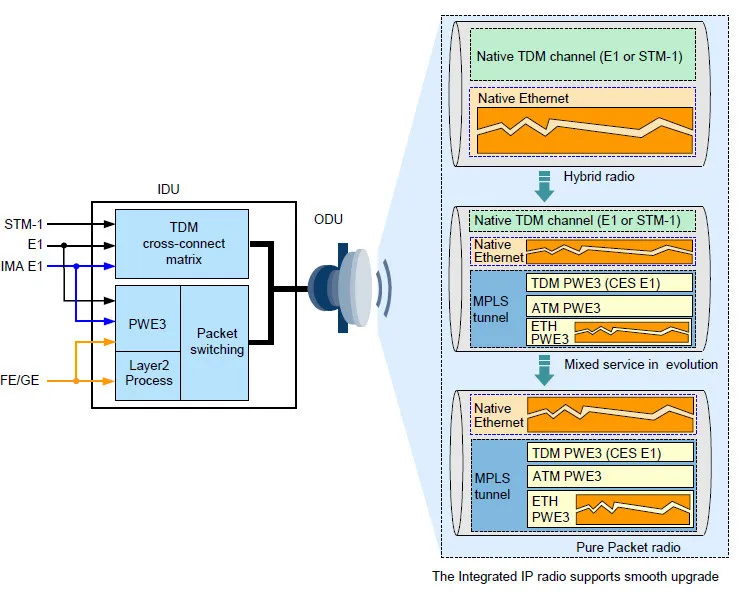The OptiX RTN 980 is large-capacity nodal microwave equipment deployed at the convergence layer. It supports the convergence of up to 20 radio links, and supports multiple protection schemes.
Consult
The OptiX RTN 980 is a product in the OptiX RTN 900 radio transmission system series.
OptiX RTN 900 Product Family
The OptiX RTN 900 series provide a variety of service interfaces and can be installed easily and configured flexibly. The OptiX RTN 900 series provide a solution that can integrate TDM microwave, Hybrid microwave, and Packet microwave technologies according to the networking scheme for the sites, achieving smooth upgrade from TDM microwave to Hybrid microwave, and from Hybrid microwave to Packet microwave. This solution meets the transmission requirements of 2G, 3G, and LTE services while also allowing for future network evolution and convergence.
There are five types of OptiX RTN 900 Packet microwave products: OptiX RTN 905, OptiX RTN 910, OptiX RTN 950, OptiX RTN 950A, and OptiX RTN 980. Users can choose the product best suited for their site.
| Product Name | IDU Appearance | Characteristic |
| OptiX RTN 905 |  |
• 1 U high IDU. |
| OptiX RTN 910 |  |
•1 U high IDU. |
| OptiX RTN 950 |  |
• 2 U high IDU. |
| OptiX RTN 950A |  |
• 2 U high IDU. |
| OptiX RTN 980 | 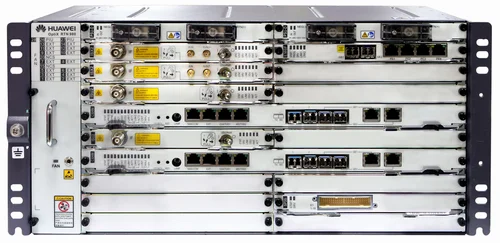 |
• 5 U high IDU. |
OptiX RTN 980
The OptiX RTN 980 is large-capacity nodal microwave equipment deployed at the convergence
layer. It supports the convergence of up to 20 radio links, and supports multiple protection schemes.
IDU 980
The IDU 980 is the indoor unit for an OptiX RTN 980 system. It receives and multiplexes
services, performs service processing and IF processing, and provides the system control and
communications function.
Features of the IDU 980
| Item | Description |
| Chassis height | 5U |
| Pluggable | Supported |
| Number of radio directions | 1 to 20 |
| RF configuration mode |
• N+0 non-protection configuration |
| Service interface type |
• E1 interface |
Appearance of the IDU 980
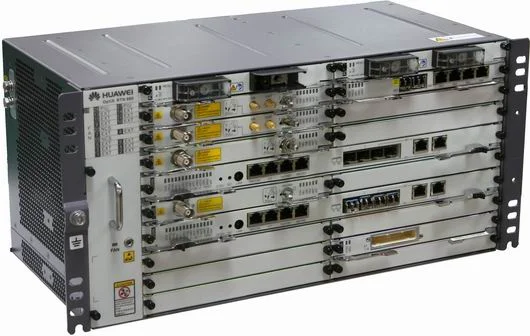
ODU
The ODU is the outdoor unit for the OptiX RTN 900. It converts frequencies and amplifies signals.
The OptiX RTN 900 product series can use the RTN 600 ODU and RTN XMC ODU, covering
the entire frequency band from 6 GHz to 42 GHz.
RTN XMC ODUs that the OptiX RTN 980 supports
| Item | Description | ||
| High-Power ODU |
Low Capacity ODU |
||
| ODU type | XMC-2 | XMC-2H | XMC-3 |
|
Frequency |
6/7/8/10/10.5/11/13/15/18/2 |
6/7/8/11 GHz |
13/15/18/23/26/ |
|
Highest-order |
2048QAM (13/15/18/23/38 GHz, |
2048QAM |
4096QAM |
|
Channel |
3.5/7/14/28/40/50/56 MHz | 7/14/28/40/50/56 MHz |
3.5/7/14/28/40/ |
RTN 600 ODUs that the OptiX RTN 980 supports
| Item | Description | ||
| High-Power ODU |
Standard Power ODU |
Low Capacity ODU |
|
| ODU type | HP, HPA | SP, SPA | LP |
| Frequency band |
6/7/8/10/10.5/11/13/ |
7/8/11/13/15/18/23/ |
7/8/11/13/15/18/23 |
|
Highest-order |
256QAM |
256QAM |
16QAM |
| Channel spacing |
7/14/28/40/56 MHz |
3.5/7/14/28 MHz | 3.5/7/14/28 MHz |
There are two methods for mounting the ODU and the antenna: direct mounting and separate
mounting.
• The direct mounting method is generally adopted when a small- or medium-diameter and single-polarized antenna is used. In this situation, if one ODU is configured for one antenna, the ODU is directly mounted at the back of the antenna. If two ODUs are configured for one antenna, an RF signal combiner/splitter (hence referred to as a hybrid coupler) must be mounted to connect the ODUs to the antenna.
The direct mounting method can also be adopted when a small- or medium-diameter and dual-polarized antenna is used. Two ODUs are mounted onto an antenna using an orthomode transducer (OMT). The method for installing an OMT is similar to that for installing a hybrid coupler.
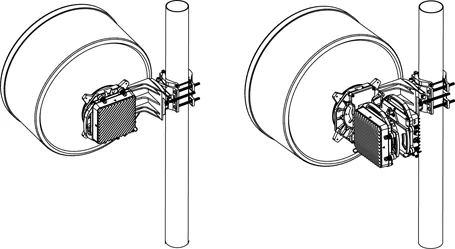
• The separate mounting method is adopted when a large- or medium-diameter and singleor
dual-polarized antenna is used.
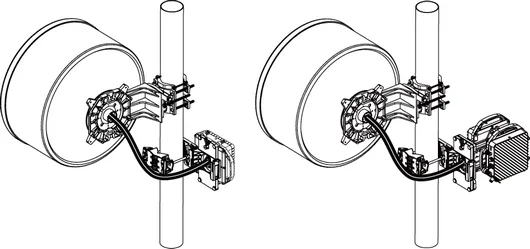
1 Microwave Types
The microwave type is determined by the IF board and the configured working mode.
2 Modulation Strategy
OptiX RTN 980 supports fixed modulation and adaptive modulation.
3 RF Configuration Modes
The OptiX RTN 980 supports 1+0 non-protection configuration, N+0 non-protection configuration, 1+1 protection configuration, N+1 protection configuration, and XPIC configuration.
4 Cross-Polarization Interference Cancellation
Cross-polarization interference cancellation (XPIC) technology is used together with co-channel
dual-polarization (CCDP). The application of the two technologies doubles the wireless link
capacity over the same channel.
5 Automatic Transmit Power Control
Automatic transmit power control (ATPC) enables the output power of the transmitter to
automatically trace the level fluctuation at the receive end within the ATPC control range. This
feature reduces the interference with neighboring systems and residual BER.
6 Capacity
The OptiX RTN 980 is a high-capacity device.
7 Interfaces
The OptiX RTN 980 provides a variety of interfaces.
8 MPLS/PWE3 Functions
The OptiX RTN 980 uses an MPLS that is optimized for the telecom bearer network as the
packet forwarding mechanism for packet transmission of carrier-class services. The OptiX RTN
980 uses PWE3 technology as the service bearer technology to implement MPLS network access
for various types of services.
9 Ethernet Service Processing Capability
The OptiX RTN 980 has powerful Ethernet service processing capability.
10 QoS
The OptiX RTN 980 provides improved quality of service (QoS) and supports the following eight types of per-hop behaviors (PHBs): BE, AF1, AF2, AF3, AF4, EF, CS6, and CS7.Therefore, network carriers can offer various QoS levels of service guarantees and build networks that carry data, voice, and video services.
11 Clock Features
The OptiX RTN 980 supports clock synchronization and IEEE 1588v2 time synchronization,
meeting the clock and time synchronization requirements of mobile networks. In addition, the
OptiX RTN 980 provides an advanced clock protection mechanism.
12 Protection Capability
The OptiX RTN 980 provides a variety of protection schemes.
13 Network Management
The OptiX RTN 980 supports multiple network management (NM) modes and provides
comprehensive NM information exchange schemes.
14 Easy Installation
The OptiX RTN 980 supports several installation modes. That is, the installation is flexible and
convenient.
15 Easy Maintenance
The OptiX RTN 980 provides plentiful maintenance features that effectively reduce the costs
associated with maintaining the equipment.
16 Security Management
The OptiX RTN 980 can prevent unauthorized logins and operations, ensuring equipment
management security.
17 Energy Saving
The OptiX RTN 980 uses various types of technologies to reduce the amount of energy that the
device consumes. The device:
18 Environmental Protection
The OptiX RTN 980 is designed to meet or exceed environmental protection requirements. The
product complies with the RoHS directive and WEEE directive.
Microwave Types
The microwave type is determined by the IF board and the configured working mode.
1.SDH Microwave
The SDH microwave refers to the microwave that transmits SDH services.
Unlike conventional SDH microwave equipment, the OptiX RTN 950A has a built-in MADM.The MADM grooms services to the microwave port through cross-connections, maps the services into the STM-1-based or 2xSTM-1-based microwave frames, and then transmits the frames. With this capability, services are flexibly groomed and the optical network and the microwave network are seamlessly converged.
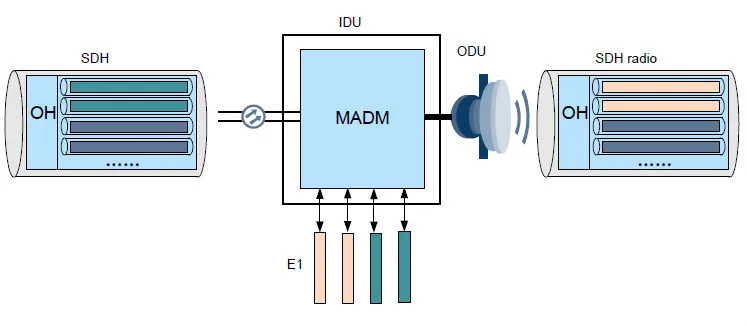
2. Hybrid/Packet Integrated IP Microwave
The Hybrid/Packet integrated IP microwave (Integrated IP radio for short) can transmit one type
among or a combination of Native TDM services, Native Ethernet services, and PWE3 packet
services according to software settings. Therefore, the Integrated IP radio achieves a smooth
upgrade from Hybrid microwave to Packet microwave.
